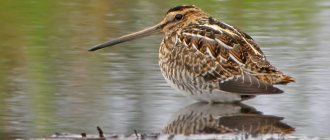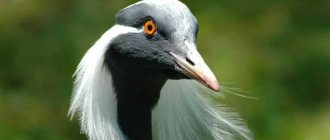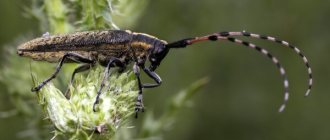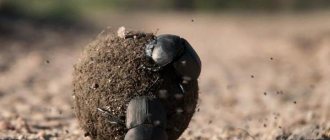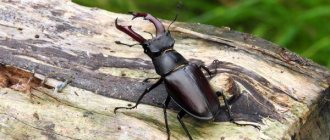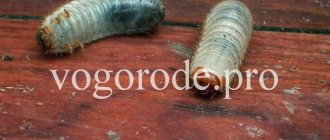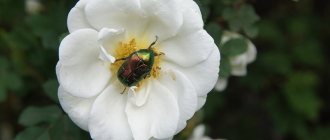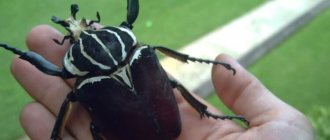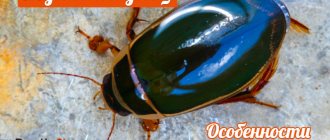The gravedigger beetle is a name that evokes hostility, and if you consider that these beetles belong to the family of carnivores, then the most negative associations arise.
But there is no need to rush; burying beetles bring enormous benefits to nature, as they “bury” dead animals. They perform the role of nature's orderlies, but at the same time they perform all actions solely for their own good; in this way they feed their own offspring. These beetles are found in large numbers near animal corpses.
There are a total of 68 species in this family. They live everywhere except Africa and Australia. There are 20 species of burying beetles living in our country.
Appearance of a burying beetle
Gravedigger beetle (Nicrophorus).
There is nothing terrible in the appearance of beetles of the carnivore family. These black beetles are quite large in size; their body length, depending on the species, ranges from 1 to 4 centimeters. Their wings are often decorated with orange or yellow irregular stripes.
Appearance of a burying beetle
Gravedigger beetle (Nicrophorus).
There is nothing terrible in the appearance of beetles of the carnivore family. These black beetles are quite large in size; their body length, depending on the species, ranges from 1 to 4 centimeters. Their wings are often decorated with orange or yellow irregular stripes. The antennae on the head have clubs at the ends, with the help of which the beetles smell decaying flesh at a distance of several hundred meters.
General characteristics[
Large beetles 11–40 mm long. The color is black, the elytra often have a bright pattern, formed from two (extremely rarely one) orange-red bands of various shapes. On the anterior edge of the clypeus there is a developed leathery border of yellow-brown color. In many species it forms a membrane that extends inside the clypeus. The shape of the membrane is different in males and females and is also species-specific. The first antennal segment is usually 1.2-1.5 times shorter than the flagellum (2nd-7th segments). A well-defined antennal club can be one color (black, brown or reddish-red), but more often it is two-colored: the apical segments are red-orange, and the main segments are black. The elytra cover the stridulatory carinae on the fifth abdominal tergite. The fore tarsi are pubescent, lamellar widened.
Practical benefits
In fact, the dung beetle is an ordinary beetle that performs complex landscape work, which is especially in demand after numerous herds of animals pass through the forest-steppe zone. It breaks down the manure left behind into organic matter that is easily absorbed into the soil and stimulates the growth of new plants.
It is noteworthy that this beetle was brought to Australia on purpose. The fact is that initially there were no ungulates there, and they were brought in by people. Within a short time, the population increased significantly, and manure began to accumulate on the surface of the soil in such quantities that it began to interfere with the growth of grass.
Over time, this could lead not only to starvation of livestock and a decline in productivity on pastures, but also to serious diseases, since the manure attracted a large number of flies, which seriously annoyed humans and were the main carriers of harmful bacteria. It was then that producers specially imported a batch of beetles from Africa, quickly achieving a reduction in the volume of manure.
Description and features
Dung beetles are representatives of the order Coleoptera, belong to the family Lamelidae and are included in the numerous subfamily of shrews. What a dung beetle looks like depends on a number of factors, in particular the species to which it belongs and its habitat. Thus, the size of the imago can vary from 1 to 7 cm, weight - from 0.75 to 1.5 g. The color can be black, brown, blue, green, yellow.
Moreover, all adult insects have:
- oval or round body shape;
- head directed forward;
- antennae consisting of 11 segments and ending in fan-shaped plates;
- three pairs of legs with serrated tibiae along the outer edge and 2 spurs on the apex;
- abdomen, consisting of 6 sternites, on which 7 spiracles are located;
- mouthparts of the gnawing type.
Also, all beetles have strong, thick, chitinous elytra, under which are leathery wings. But not all drillers can fly; some have completely lost the ability to move through the air.
Interesting! During flight, the elytra of dung beetles practically do not open. This contradicts all the laws of aerodynamics, but does not interfere with the insects themselves. Their flight is so masterly and precise that they can easily catch a moving fly (even many birds cannot do such a trick!)
Features of behavior
Gravediggers spend most of their lives in splendid isolation, scouring the area in search of carrion. They are helped in this by special receptors located at the end of the antennae. Thanks to them, the beetle is able to smell the smell of a decomposing body at a distance of more than 100 meters. And after that, nothing will stop the stubborn insect from traveling to its intended goal.
Having discovered the object of its search, the gravedigger beetle soberly assesses the suitability of the prey. If the object is in good condition, then it emits an aromatic signal, notifying its closest relatives about a valuable find. Often, help arrives quite quickly, after which a careful distribution of roles begins.
So, if a male finds the prey, then it is he who has the right to be the head of the new family. If it was a female, then she chooses the most worthy gentleman as her husband. By the way, most often it is the males who find the corpses of animals, since they devote much more time to this process than their halves.
How do they bury corpses?
Considering the small size of insects, a completely logical question arises: “How do they bury the found remains of animals?” In fact, everything is quite simple here. The beetles simply dig under the body and begin to loosen the ground. This causes the soil to become less dense, and the remains begin to gradually sink down, as if sinking into quicksand.
More remarkable is the way in which burying beetles process the body after it is “buried.” So, they clean it of wool or feathers, and then cover it with a special antibacterial secretion from the glands. Thanks to this, the corpse of an animal can lie underground for several weeks without decomposing.
Wasps
The insects themselves feed on flower nectar and fruit juice, but their queen and larvae need protein food, so adult individuals have to hunt a lot. Perhaps the wasp is the most dangerous winged predator on our list today. Some of the species, for example, the Larra burrowing wasp, are capable of destroying even a mole cricket, and those that live in our area calmly cope with flies, beetles, bedbugs, and, of course, mosquitoes, leaf rollers and aphids.
Some types of wasps, such as typhus, paralyze the victim with their venom and then lay an egg in its body. The effect of the poison lasts for several hours, then the larva continues to move, and a new insect develops inside it, feeding on it. In order to carry out this procedure with Khrushchev, wasps can dig holes in the ground to a depth of 10 cm.
The true purpose of a corpse
As mentioned earlier, adult burying beetles rarely eat remains found on the road. Instead, they unanimously bury the corpse in the ground, which is why, in fact, these insects got their gloomy name. But the reason for this behavior is not the desire to clear the forest of rotting carrion, but a completely natural desire to continue the family line.
Thus, a “buried” corpse is an excellent source of food for the younger generation of beetles. That is, only after the find is buried in the ground do the gravediggers begin to mate. And then the female simply lays eggs next to the carrion, thereby guaranteeing the children’s safety when they are born.
Is the burying beetle really omnivorous: what does this species eat?
Despite the fact that this species belongs to the family of carrion eaters, the basis of its diet is not carrion. Naturally, they also eat animal corpses, but in this case there are a number of rules that limit the beetles in their appetite. The reason for this behavior lies in the peculiarities of the reproduction process of gravediggers, but we will consider this issue a little later.
More importantly, beetles are aggressive predators that eat other insects. By and large, hunting is carried out on small inhabitants of their habitat, such as aphids, ladybugs, caterpillars, and so on. Simply put, burying beetles are capable of eating anything that can fit into their mouths.
Habitat
In what countries does the gravedigger beetle live? Photos taken by naturalists prove that representatives of this species can be found in almost all corners of the planet, with the exception of Australia and some parts of Africa. At the same time, the gravediggers themselves prefer to settle in forests, but even in the steppe they will feel more than comfortable. The main thing is that the area is abundantly filled with food, since this species is very voracious.
Chemicals against wireworms
If folk and mechanical means of combating wireworms or click beetles do not help, and the problem is so serious and large-scale, then you should start using special chemicals against the underground pest, in other words, insecticides. As a rule, the following chemical agents against wireworms are most popular among summer residents:
- chops;
- Barguzin;
- Provotox;
- Zemlin;
- Bazudin;
- Initiative.
As a rule, the main active ingredient in such products is the same - diazinon.
Prestige and Matador are considered very popular and effective as pre-planting chemical treatments.
When potato tops appear, you can spray the plantings with Anti-Khrushchev solution against wireworms.
The onset of spring brings with it one painfully familiar problem to all summer residents: the invasion of the malicious pest of the click beetle and its wireworm larvae - a real thunderstorm for nightshades, cereals, and aster crops. The whole range of measures of correct agricultural technology outlined above will help to nip its spread in the bud.
Video: ways to combat wireworms in the garden
Fighting methods
Of the beetle's enemies, it is worth noting starlings, sparrows, shrikes, beetles, storks, and hoopoes. The shrew destroys the larvae. Predatory flies and wasps can also help reduce insect numbers.
When using Metaphos, Chlorophos, Sumition, Decis extra 3 weeks before harvest, you can destroy up to 90% of pests. Among the drugs, Parachute, Karate Zeon, and Ephoria are also effective.
Folk remedies include spraying with vinegar solution and dusting with birch ash. Powder is usually applied in the morning. Ash is also sprinkled between the rows.
What does an elephant eat?
The insect is not selective in food; it consumes leaves, stems, and eats the fruits and roots of the plant. Depending on what the elephant beetle eats, entomologists divide insects into the following groups:
- Monophages are pests that consume strictly one type of plant.
- Oligophages are beetles that feed on garden crops that are similar in appearance.
- Polyphages are omnivores that destroy any vegetation in their path.
These features mainly determine the habitats of weevils.
Some representatives of the species can be beneficial to humans. We are talking about mass destruction of weeds. Such insects are widespread in Brazil and Australia. Several types of useful mowers were brought to Russian territory, where to this day they continue to fight against salvinia, which pollutes water bodies.
Why are kravchiki dangerous?
Red beetles are indigenous inhabitants of steppes and forest-steppes. Living on wild virgin steppes, they, of course, ate local vegetation, but with the arrival of humans they quickly turned into dangerous pests. When preparing food for their offspring, beetles damage many shoots,
which they cut off with their powerful jaws. Thus, they are very harmful to pastures, fields, vegetable gardens and especially vineyards . One beetle cuts up to ten grape shoots per day!
Kravchiki cause enormous damage to sunflowers and corn. Beetles also damage young woody plants in nurseries, sometimes completely cutting off all the shoots. A family of bigheaded fish that has settled in a garden can destroy almost the entire crop. The inhabitants of just four burrows located on one square meter are capable of completely destroying all vegetation on ten square meters!
Skin beetle bites
Carpet beetles
These insects can appear in residential areas. They feel pretty good there, so they begin to reproduce en masse.
The size of skin beetles is small (0.3 to 12 mm), the body is oval in shape, with a hard shell, colored in different shades of brown. The larvae are black, covered with many hard hairs.
Note. Skin beetles feed on dead organic matter and are not blood-sucking insects.
There is no evidence in the biological and medical literature that individuals belonging to this family can bite people. There are also no reliably confirmed facts of this.
But people often notice a correlation between the appearance of small red dots and skin irritation when they appear in the house. Most likely, this is caused by an allergy to the hairs of the larvae, which, with prolonged contact, irritate the human skin (which can happen during sleep).
Who are earthen fleas, what are they?
Ground fleas have nothing to do with real fleas - they are completely different insects that do not bite and do not drink blood. All flea beetles (and there are about 10,000 species of them in the world!) are representatives of the family of leaf beetles, which means that it is clear that they choose plant tissues as food.
These are small and very small bugs (1-5 mm long) with hard elytra, which can really jump far and high (relative to their size) thanks to their strong hind legs (for such jumping ability they are nicknamed “fleas”). Sitting on a plant, flea beetles often “hide” their antennae and legs under their bodies. Body color varies from inconspicuous monochromatic gray, black or brown to fairly bright shades (metallic blue and green, orange, bronze, white-black or white-yellow striped, etc.).
All flea beetles are herbivorous, but some “specialize” on specific crops (monophagous and oligophagous), while others easily switch from one type of plant food to another (polyphagous). The food specialty is easy to track by the names of the beetles - potato flea beetles, cruciferous flea beetles, beet flea beetles, grain flea beetles, flax flea beetles, etc. Before the emergence of cultivated plants, flea beetles feed on their wild “analogues” and other weeds.
- All garden pests in tables with descriptions, photos and control measures
We have compiled a “dossier” for you on each pest - save this collection!
How to deal with click beetle and wireworm?
To cope with the pest and preserve the harvest, it is necessary to apply comprehensive control measures. Only in this case can you count on the click beetles and their larvae completely disappearing from the area.
Agrotechnical measures
To get rid of pests, it is necessary to create unfavorable conditions for their wintering, reproduction and life.
Pest
The main agrotechnical measures against click beetles and their larvae are as follows:
- In the fall, before frost sets in, you should dig up the area to the depth of a shovel.
- In spring and summer, you need to constantly loosen the rows and weed the crops to prevent stagnation of moisture, which is necessary for the eggs and larvae of the pest.
- When planting, peas or beans, onion peels, and tobacco dust should be placed in the holes to repel wireworms.
- It is necessary to regularly add mineral fertilizers and eggshells to the soil, which the pest cannot tolerate.
- It makes sense to plant marigolds along the perimeter of the site and between rows of vegetable and cereal crops, the smell of which repels the pest.
Chemical control agents
To prevent potato tubers from being damaged by click beetle larvae, the planting material should be treated with chemicals.
Effective means:
- Prestige. To spray tubers, you need to dissolve 10 ml of insecticide in 10 liters of water. The tubers should be laid out on film or tarpaulin in one layer. Spray them with the resulting product, then mix and repeat the procedure. After treatment, the tubers must be at least 75% covered with the solution.
- Aktara. The drug should be used at the rate of 1.6 g per 10 liters of water. The resulting solution should be used to water the holes when planting potatoes. You should also additionally spray the product onto the top layer of soil after completion.
- Taboo. The drug should be used to treat tubers and soak the roots of seedlings before planting. To do this, dilute 10 ml in 1.5 liters of water.
Traps
You can also fight wireworms using traps. To do this, you need to cut a potato, beet or carrot tuber, put it on a stick and bury it in the ground to a depth of 10 cm so that the stick sticks out. After a few days, remove and destroy the wireworms.
You can also use a half-liter jar as a trap, inside which you should place pieces of root vegetables, and then bury it in the ground. And every 2-3 days you should take it out and destroy the wireworms.
Sweet traps can also be used against adult pests. To do this, you need to collect water and sugar in small containers and place them around the garden to attract click beetles. Weather traps daily and destroy insects.
Taboo
How to detect flea beetles in the garden
Both adult beetles and leaf beetle larvae actively scrape the surface of leaves or gnaw rounded pits and holes in them - up to the skeletonization of leaf blades. Less commonly, tunnels are gnawed out inside the stems. Also, the larvae are not averse to eating plant roots. Plants deprived of a photosynthetic apparatus quickly wither, wither, dry out and die. In addition, during the feeding process, insects very often damage the apical buds of seedlings and root collars and destroy growth points.
During mass reproduction, when there are from 50 to 200 individuals on one plant, flea beetles can destroy all seedlings or young shoots in a few days, and the so-called “economic threshold of harmfulness” is established when there are already about 10 individual beetles per 1 sq.m.
Most of all, cruciferous crops (their pests are wavy flea beetle, black flea beetle, swamp flea beetle, light-legged flea beetle, bronze flea beetle, etc.), beets (several types of beet flea beetle, buckwheat flea beetle, root flea beetle), grains (stem flea beetle, southern stem flea beetle, striped bread flea beetle, large bread flea beetle), potatoes and other nightshades (yellow potato flea beetle).
- Which bugs in the garden should you definitely get rid of: top 7 pests
Unfortunately, many of the flying and crawling guests of your garden appeared on the site with not the best intentions. We study pest beetles.
Features of burying beetles
Two gravediggers go “to work.”
Gravediggers have a certain peculiarity: if a male discovers a corpse, he climbs onto a plant stem or some hill and lifts the tip of his abdomen upward, while a specific smell is released from the glands. The female smells this smell. When the female flies to the call of the male, the pair examines the prey and begins to work. In a couple of days, the female and male are able to “bury” the mole.
If circumstances are such that the gravedigger beetle fails to find the corpse, it has to lay eggs in the mushroom.
Beetles of this species have another ability - they treat the corpse with a special secretion, which contains the enzyme lysozyme, which has an antibacterial effect. This enzyme prevents the remains from decomposing. It is worth noting that lysozyme is a component of the immunity of most living organisms. For example, humans have lysozyme in saliva. After this kind of sanitary treatment, the carcass becomes an excellent food option for the larvae. If parents did not take such sensitive care of their offspring, about 40% of them would die.
The insects treat the corpse with a special secretion.
Quite often, strange “passengers”—gamasid mites—settle on the backs of burying beetles. The gravediggers have to tolerate these tactless travelers and transport them on their own backs to the animal corpses. The thing is, these mites, like lysozyme, fight pathogenic microflora, since they feed on microorganisms that accelerate the process of decomposition of corpses. This is another example of the amazing interaction of living beings in nature.
If you find an error, please select a piece of text and press Ctrl+Enter.
Caring for offspring
The appearance of carrion eaters is remarkable for its color.
Why do carrion beetles need animal corpses? Adult beetles feed mostly on insects rather than carrion.
When a beetle discovers carrion, it carefully inspects the area and evaluates the soil. After this, the gravedigger begins to dig the earth around the dead animal using his paws. In males, the body structure is more adapted to digging, since their paws are more expanded than the paws of females.
A clear example of the “work” of a burying beetle.
When a mound of earth forms around the dead animal, the beetle continues to dig under the corpse, while it sinks deeper into the soil. As a rule, gravediggers bury corpses to a depth of about 30-50 centimeters.
After mating, the female drives away the male and makes a passage away from the dead carcass. In the resulting small chamber, she lays several dozen eggs. This niche is called a brood chamber. After this, the female regurgitates the contents of the digestive tract into the animal’s corpse. Digestive juice will dissolve the flesh and turn it into a nutritious mass on which the offspring will feed.
By decomposing the corpses of animals, the gravedigger clears the fauna of unnecessary remains.
For several days, the female does not leave the eggs and takes care of them: licks them and turns them over, thus protecting them from mold.
After some time, blind white larvae emerge from the eggs. They have underdeveloped limbs. They crawl along the trench to the remains of the animal and begin to feed. The larvae are very voracious. They stay underground for about 12 days, and they quickly gain weight and develop. During their stay underground, the larvae molt 4 times. And then comes the pupal phase. This phase does not last long - after 2 weeks an adult beetle appears.
